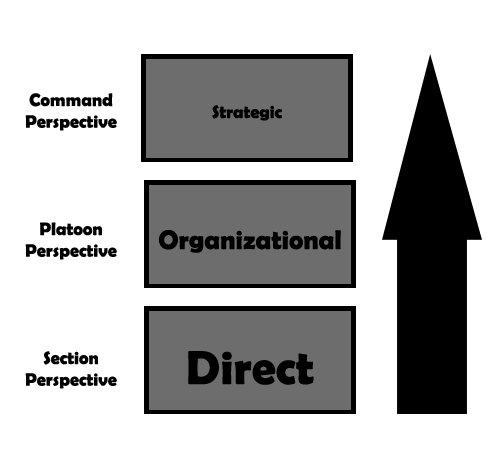Direct Leadership
Page 1 of 1
 Direct Leadership
Direct Leadership

This diagram identifies the core leader competencies and their subsets.
[size=14pt]EXCELLING AT THE CORE LEADER COMPETENCIES[/size]
(1) Leader competence develops from a balanced combination of real-world schooling, self-development, unit training, and experience. Building competence follows a systematic and gradual approach, from mastering individual competencies, to applying them and tailoring them to the situation at hand. Leading people by giving them a complex task helps them develop the confidence and will to take on progressively more difficult challenges.
(2) Why competencies? Competencies provide a clear and consistent way of conveying expectations for leaders. Current and future leaders want to know what to do to succeed in their leadership responsibilities. The core leader competencies apply across all levels of the unit, across different positions and jobs. Competencies are demonstrated through behaviors that can be readily observed and assessed by a spectrum of leaders and followers: superiors, subordinates, peers, and mentors. This makes them a good basis for leader development and focused multi-source assessment and feedback.
(3) Leader competencies improve over extended periods. Leaders acquire the basic competencies at the direct leadership level. As the leader moves to organizational and strategic level positions, the competencies provide the basis for leading through change. Leaders continuously refine and extend the ability to perform these competencies proficiently and learn to apply them to increasingly complex situations.
(4) These competencies are developed, sustained, and improved by performing one’s assigned tasks and missions. Leaders do not wait until realism matches to develop their leader competencies. They use every training opportunity to assess and improve their ability to lead Soldiers.
(5) To improve their proficiency, leaders can take advantage of chances to learn and gain experience in the leader competencies. They should look for new learning opportunities, ask questions, seek training opportunities, and request performance critiques. This approach to learning ensures leaders remain viable as a professional member of the community.

This diagram identifies the NCO Vision.
(1) The Unit relies on NCOs who are capable of executing complex tactical operations, making intent-driven decisions, and who can operate among other NCOs efficiently. They must take the information provided by their leaders and pass it on to their subordinates. Soldiers look to their NCOs for solutions, guidance, and inspiration. Soldiers can relate to NCOs since NCOs are promoted from the junior enlisted ranks. They expect them to be the buffer, filtering information from the commissioned officers and providing them with the day-to-day guidance to get the job done. To answer the challenges of the contemporary community, NCOs must train their Soldiers to cope, prepare, and perform no matter what the situation. In short, the NCO of today is a warrior-leader of strong character, comfortable in every role outlined in the NCO Corps’ vision.
"NCOs like to make a decision right away and move on to the next thing…so the higher up the flagpole you go, the more you have to learn a very different style of leadership."
- Douglas E. Murray
Command Sergeant Major, U.S. Army Reserve (1989)

(1) The diagram shows the three levels of unit leadership: direct, organizational, and strategic. Factors determining a position’s leadership level can include the size of the unit or organization, the type of operations it conducts, the number of people assigned, and its planning horizon.- Douglas E. Murray
Command Sergeant Major, U.S. Army Reserve (1989)

(2) Most NCOs serve at the direct leadership level. Some senior NCOs will serve at the organizational leadership level. Primarily officers and equivalent senior NCOs serve at the strategic leadership levels. Often, the rank or grade of the leader holding a position does not indicate the position’s leadership level. That is why the diagram does not show rank. A Technical Sergeant serving as a platoon sergeant works at the organizational leadership level. If the same NCO holds a headquarters job dealing with issues and policy affecting the whole unit, that NCO works at the command leadership level. However, if the sergeant’s primary duty is running a staff section that conducts Basic Combat Training operations, the NCO is a direct leader.
(3) It is important to realize that the Command echelon alone does not determine a position’s leadership level. Leaders of all ranks and grades serve in strategic-level headquarters, but they are not all strategic-level leaders. The responsibilities of a duty position together with the factors usually determine its leadership level. For example, The Company Clerk may have dozens of men working for him in S-1, but his leadership level is only Direct, not Strategic.
[size=14pt]DIRECT LEADERSHIP[/size]
(1) Direct leadership is face-to-face or first-line leadership. It generally occurs in organizations where subordinates are accustomed to seeing their leaders all the time: Elements and Sections. The direct leader’s span of influence may range from a handful to most, if not all. NCOs are in direct leadership positions more often than their officer counterparts.
(2) Direct leaders develop their subordinates one-on-one and influence the organization indirectly through their subordinates. Direct leaders generally experience more certainty and less complexity than organizational and
strategic leaders. Mainly, they are close enough to the action to determine or address problems.
[size=14pt]ORGANIZATIONAL LEADERSHIP[/size]
(1) Organizational leaders influence dozens of people at a time. They do this indirectly, generally through more levels of subordinates than do direct leaders. The additional levels of subordinates can make it more difficult for them to see and judge immediate results. Organizational leaders have staffs to help them lead their people and manage the units' resources. They establish policies and the organizational climate that support their subordinate leaders.
(2) While the same core leader competencies apply to all levels of leadership, organizational leaders usually deal with more complexity, more people, greater uncertainty, and a greater number of unintended consequences. Organizational leaders influence people through policymaking and systems integration rather than through face-to-face contact.
[size=14pt]STRATEGIC LEADERSHIP[/size]
(1) Strategic leaders include leaders at the command levels. Strategic leaders are responsible for the entire organization, and can possibly influence hundreds of people. They establish unit structure, allocate resources, communicate their vision, and prepare their commands tactically.
(2) Strategic leaders work in uncertain environments that present highly complex problems affecting everyone in the unit. Strategic leaders apply all core leader competencies they acquired as direct and organizational leaders, while further adapting them to the more complex realities of their strategic environment. Since that environment includes all unit functions, strategic leader decisions must also take into account such things as budgetary constraints, new server acquisition, development, and inter-unit cooperation.
(3) Strategic leaders, like direct and organizational leaders, process information quickly, assess alternatives based on incomplete data, make decisions, and generate support. However, strategic leaders’ decisions affect more people, commit more resources, and have wider-ranging consequences than do decisions of organizational and direct leaders.
[size=14pt]FORMAL LEADERSHIP[/size]
(1) Legitimate or formal leadership is granted to individuals by virtue of assignment to positions of responsibility and is a function of rank and experience. The positions themselves are based on the leader’s level of job experience and training. NCOs assume legitimate authority when assigned as a platoon sergeant or First Sergeant. These positions bring with them the duty to recommend disciplinary actions and advancement for promotion.
[size=14pt]INFORMAL LEADERSHIP
[/size]
(1) Informal leadership can be found throughout organizations, and while it can play an important role in mission accomplishment, it should never undermine legitimate authority. All members of the unit could find themselves in a position to serve as a leader at any time. Informal leadership is not based on any particular rank or position in the unit. Therefore, even the most junior member may be able to lead a team into battle.
Page 1 of 1
Permissions in this forum:
You cannot reply to topics in this forum|
|
|
